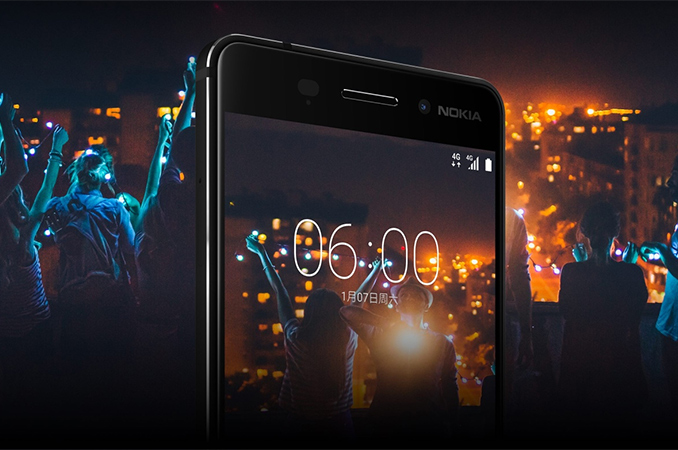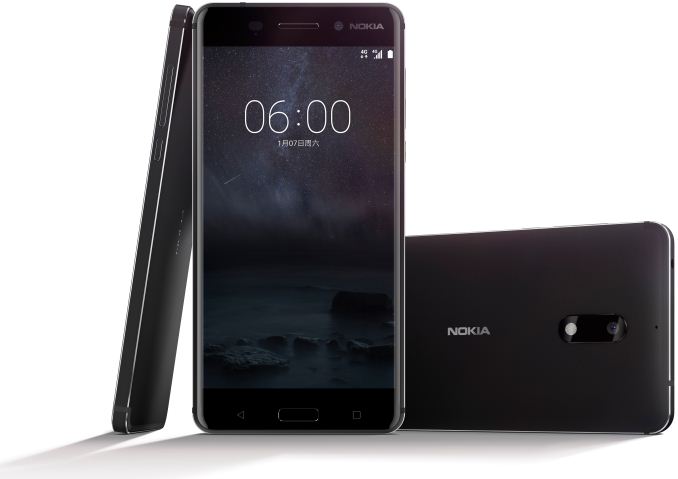Nokia 6 Announced: Qualcomm Snapdragon 430, 5.5-Inch Display, Android 7
by Anton Shilov on January 9, 2017 2:05 PM EST- Posted in
- Smartphones
- Snapdragon
- Nokia
- Qualcomm
- Android
- Foxconn
- HMD Global
- Nougat

On the day CES 2017 closed its doors, HMD Global introduced its first Nokia-branded smartphone that will be available exclusively in China in the coming weeks. The Nokia 6 handset will feature a 5.5-inch display, a mainstream Qualcomm SoC and will come in an aluminum uni-body. Later on, the company plans to introduce new Nokia smartphones for other regions.
Just in case you were not following Nokia recently, HMD Global (a company established and run mostly by former Nokia executives) and FIH Mobile (a subsidiary of Foxconn) inked several deals with Microsoft and Nokia last year that gives them an ability to develop (under supervision of Nokia), build and sell Nokia-branded smartphones based on the Google Android OS. In particular, HMD obtained exclusive rights to use the Nokia trademark on mobile phones and tablets globally (except Japan) for the next 10 years, standard essential cellular patent licenses, software for feature phones and some other IP. Meanwhile, Foxconn acquired a manufacturing facility in Hanoi, Vietnam, which is used to produce Nokia-branded devices along with customer contracts, critical supply agreements, sales and distribution assets and so on. Under the terms of the agreements, HMD will handle development as well as marketing and will have full operational control of sales and distribution of Nokia-branded mobile phones and tablets (even though formally these assets belong to Foxconn).
The Nokia 6 will be the first smartphone developed by HMD with certain input from Nokia. Despite being the first, the new unit will not be a flagship halo product for the global audience, but a mainstream solution aimed at the world’s largest market (in terms of volume). The move makes sense because HMD needs to earn money and capture market share to ensure long-term success and China is a good place to start.
Inside the Nokia 6 is Qualcomm’s 430 SoC with eight ARM Cortex-A53 general-purpose cores at up to 1.4GHz, an Adreno 505 GPU and an integrated X6 LTE modem. The SoC is accompanies by a generous 4GB of LPDDR3 RAM as well as 64GB of internal NAND flash memory (without further expansion capabilities). The phone has a 5.5-inch FHD IPS display with a polarizer film covered with 2.5D Gorilla Glass for protection. Imaging capabilities of the Nokia 6 include a 16MP sensor with f/2.0 aperture (we do not know whether this one has OIS or other premium features, but most likely it does not) and a dual LED flash on the back as well as an 8MP sensor with f/2.0 aperture on the front. As for audio, the handset has a 3.5-mm TRRS audio jack on top, stereo speakers located on top and bottom edges as well as software support for Dolby Atmos. For local connectivity, the phone uses 802.11ac Wi-Fi, Bluetooth 4.1 and a microUSB port. The smartphone is powered by a 3000mAh battery, but so far HMD has not disclosed details about its battery life and other peculiarities.
| Nokia 6 Preliminary Specifications | |
| SoC | Qualcomm Snapdragon 430 (MSM8937) 8x ARM Cortex-A53 @ 1.4 GHz Adreno 505 |
| RAM | 4GB LPDDR3 |
| Storage | 64GB (eMMC) |
| Display | 5.5-inch 1920x1080 (403 ppi) with 2.5D Gorilla Glass |
| Network | 4G: LTE FDD, LTE TDD 3G: WCDMA (DC-HSPA+, DC-HSUPA), CDMA1x, EV-DO, TD-SCDMA 2G: GSM/EDGE |
| LTE | Down: 150 Mb/s Up: 75 Mb/s |
| Audio | Stereo speakers 3.5-mm TRRS audio jack 2x NXP TFA9891 amplifiers (rumoured) Dolby Atmos support |
| Dimensions | 154 × 75.8 × 7.85 mm (rumoured) |
| Rear Camera | 16MP with f/2.0 aperture and dual LED flash |
| Front Camera | 8MP with f/2.0 aperture |
| Battery | 3000mAh (rumoured) |
| OS | Android 7 |
| Connectivity | 802.11ac Wi-Fi, Bluetooth 4.1, microUSB 2.0 |
| Navigation | GPS, GLONASS |
| SIM Size | 2x NanoSIM |
| Colors | Black |
| Launch Country | China |
| Price | ¥1699 ($245) |
The Nokia 6 comes in a black 6000-series aluminum uni-body chassis with flat edges that are milled using a CNC machine from a single brick of aluminum. Nokia says that the enclosure is then anodized twice and polished five times. The antenna is separated from the rest of the back cover using polycarbonate strips (a popular method nowadays), but it is hard to tell based on pictures how well the lines match the color and texture of the chassis. Meanwhile, flat edges of the device are polished to prevent them from wearing out, whereas the glass has curved edges to give the phone a smoother feeling during use. Following the latest trends, developers also opted for capacitive touch home, back and recent apps buttons on the Nokia 6. Overall, HMD and Nokia tried to give their mainstream smartphone a premium look and feel. Instead of using polycarbonate, like the Lumia family, it switched to aluminum, which may not be the most durable material, but which at least looks good.
When it comes to the operating system, the Nokia 6 will run Android 7, but it is unclear whether the OS has any enhancements or exclusive features. It is possible that the mainstream smartphone for China will only offer “vanilla” Android, which helps to speed up its time-to-market.
HMD Global will participate in MWC next month and this is where the company is expected to introduce other models in the new lineup of Nokia-branded smartphones. Meanwhile, it is interesting to note that the company announced the first Android-based Nokia smartphone (and, basically, the return of the brand to the smartphone market) a day before the 10th anniversary of Apple’s iPhone announcement.
The Nokia 6 smartphone will be available in the coming weeks in China, exclusively from JD.com for ¥1699 ($245).
Related Reading:
- HMD Closes Nokia Brand and Patents Deal with Microsoft, Smartphones Due in 2017
- Nokia Is Set to Return to Smartphones and Tablets: What to Expect?
- Microsoft Streamlines Its Smartphone Business Again, Lays Off 1850 People
- HP’s Elite x3 Windows 10 Smartphone to Cost $699, Set to Be Available Worldwide
Source: HMD Global


















36 Comments
View All Comments
BrokenCrayons - Monday, January 9, 2017 - link
"The Nokia 6 comes in a black 6000-series aluminum uni-body chassis with flat edges that are milled using a CNC machine from a single brick of aluminum. Nokia says that the enclosure is then anodized twice and polished five times."That sounds like a lot of work for something that's only going to be relevant for one to two years during which it'll become uninteresting and then obsolete or end up getting dropped into a toilet bowl. At least the cost is relatively low, but still, why bother with all the effort?
Michael Bay - Monday, January 9, 2017 - link
Because it`s the only differentiator in this race to the bottom they`ve got.close - Monday, January 9, 2017 - link
They did save on the USB Type C though. They probably used that money to double polish the phone... Or something.flyingpants1 - Monday, January 9, 2017 - link
That's completely stupid. The differentiators are front speakers, 5000mah battery, SD card, wireless charging and waterproofing.If someone made a 5.2" phone with 4000mah battery, and front speakers, it would sell out immediately
Alexey291 - Monday, January 9, 2017 - link
Why do front speakers matter on a smartphone again sorry?xdrol - Monday, January 9, 2017 - link
I don't usually put my phone on the desk face-down. Or watch videos on the backside. I literally don't even why are the speakers on the back.vastac13 - Monday, January 9, 2017 - link
Ask Samsung.. hahaha!Alexey291 - Tuesday, January 10, 2017 - link
Somehow given the quality that you can get out of speakers this size I don't think it matters where they are placed. Might as well be on the moon for all that it matters.Murloc - Tuesday, January 10, 2017 - link
this.I can hear the sound of videos perfectly fine with a rear facing speaker.
If I want to put down the phone while I listen I can just put it down face down.
niva - Tuesday, January 10, 2017 - link
Yeah, and people around you can hear that even better. Front facing speakers, even if it's just one, is a huge deal. There's absolutely no reason why the sound should be blasted in any other direction than towards you. If this phone comes with straight vanilla Android I actually want one.